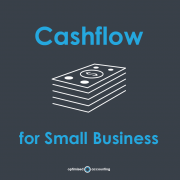
Inflation is a term that we’ve all heard quite frequently lately, with rates rapidly increasing. Small businesses are particularly feeling the effects of inflation, with supplies costing more, employee shortages, and shrinking profits. In this article, we’ll explain what inflation is, how it affects small businesses, and offer 7 tips to help adjust for inflation.
What is inflation?
Inflation is the increase in the prices of goods and services. This means that everything, from a can of soup to a house, costs more to buy. Over time, prices of goods and services increase due to a variety of factors such as supply and demand, production costs, worker shortages, printing money, and rising wages.
This is purposeful to some degree. Economists generally agree that a target rate of 2% annually is desirable to keep balance in the economy and promote growth. This rate allows central banks to lower interest rates to stimulate the economy if necessary without putting too much of a burden on the consumer.
When the entire picture is considered, you can see why understanding any given inflation situation becomes a matter of healthy debate. While it’s clear that we as individuals have little control over inflation, we all want to know what it means for our bank accounts.
How does inflation affect small businesses?
Small businesses are particularly vulnerable to inflation because they have less financial cushion than larger businesses. When inflation causes the cost of goods and services to increase, small businesses have to bear the burden of those costs without the same resources as larger companies. For example, if a small business sells a product for $10 and the cost of producing that product increases to $12 due to inflation, the business will either have to absorb the extra cost or pass it onto customers, which could hurt sales.
Buying Power Inflation affects the buying power of consumers. Any time your savings grow slower than the inflation rate, you will effectively lose money. Put simply, the money in your savings account must earn a higher interest rate than the inflation rate to continue to hold the same value. Currently, the global inflation rate is a few percentage points higher than the average savings account pays in interest. So while you have the same dollar amount in your account, that money now buys less than it could when prices were lower.
The Rule of 72
To understand what this discrepancy looks like, the Rule of 72 may prove useful. While it’s only to be used as a general estimate and won’t consider many factors, such as the inflation rate will unlikely remain the same for 11 years or anywhere close to that. However, it can help you imagine what will happen to your money if rates continue at their current level.
To determine how long your savings will take to double, take 72 and divide it by your annual interest rate. For example, if you hold $100 in a savings account with a 2.5% interest rate, it would take 28.8 years for that account to reach a balance of $200.
You can also use the rule to calculate how quickly these new higher prices would halve the value of your savings. Take 72 and divide it by the annual rate of inflation. If it’s currently 6.5%, for example, it would take just over 11 years for your $100 to be worth $50.
You can see why an inflation rate higher than the interest your customers is earning is problematic. This can impact the revenue of small businesses. When prices increase, consumers are less likely to purchase goods and services, and when small businesses have to increase prices to cover the cost of inflation, this can further impact consumer purchasing power. This is why it’s crucial for small businesses to adjust to inflation to maintain profitability.
7 Tips to Help Small Businesses Adjust for Inflation
1. Study your data
It’s important to analyze your financial data to understand which products and services generate the most revenue and which ones are costing you the most. Use this information to adjust your business model to minimize expenses and maximize profitability.
2. Cut expenses
Once you’ve analyzed your financial data, cut expenses wherever possible. This may mean simplifying your product or service offerings, reducing overhead costs, or cutting back on marketing expenses.
It’s nice to be able to offer many products and services, but this is a time to tighten your belt. Focus on the items that keep your business as healthy as possible, and ditch the rest – at least for the time being. If you can make one product provide more than one income source, such as packaging small pieces of knowledge you usually provide your service clients as a digital product, you will extend the effectiveness of your cuts.
In the same vein, if you have contracts with suppliers or vendors, consider renegotiating the terms of those contracts to help offset the cost of inflation.
3. Adjust your prices
While it’s never easy to raise prices, it’s important to adjust your pricing to keep up with inflation. This may mean increasing the price of certain products or services or adjusting your pricing structure altogether.
Keeping prices the same would indeed be wonderful for your customers or clients. However, if you’re offering your products or services at the same prices as before inflation started to climb rapidly, you’re absorbing the cost. When you dig into your data, you may find that some things you offer actually cost you a lot of money. That’s not a sustainable business model – raise your prices to keep yourself afloat, or find items that cost less for you to sell.
4. Simplify and automate
If aspects of your business take a long time to complete, see if there’s anything you can do to reduce those hours. Switching to cloud accounting or inventory management software would be excellent examples, as doing so would allow you to use your valuable time elsewhere.
Identify where you can simplify and automate, and then do it. Even when inflation comes back under control, you will undoubtedly find that the saved time helps.
With that said, keep your employees in mind. Good help is hard to find. Those who work for you are feeling the pinch as well. While it’s essential to automate what you can, you must consider the consequences it will have on your staff. Identify how you can better use their talents if parts of their roles become automated.
5. Focus on your customer
Remember that your customers are keeping you in business and experiencing inflation in their lives too – both at home and in their own businesses.
Keep the lines of communication clear and open, especially if you’re going to alter your offerings or raise your prices. It’s a lot easier to retain loyal customers than it is to gain new ones, so make sure they know how much you value them and communicate openly to maintain their trust and loyalty.
6. Stay flexible
Inflation rates can change quickly, so it’s important to remain flexible and adjust your business strategy accordingly. Stay open to new opportunities and be willing to adapt your business to changing market conditions.
7. Maintain communication with customers
Keep your customers informed about any price changes or adjustments to your products or services due to inflation. This will help build trust and maintain a strong relationship with your customer base.
In conclusion, inflation is an economic reality that can have a significant impact on small businesses. However, by studying your financial data, cutting expenses, adjusting prices, renegotiating contracts, diversifying your revenue streams, staying flexible, and maintaining communication with customers, you can help your small business weather the storm of inflation and maintain profitability.
Be even more on top of business pitfalls
You’re a business that stays in tune with your finances to stay ahead. So does our newsletter, so come on board for more heads-up:










